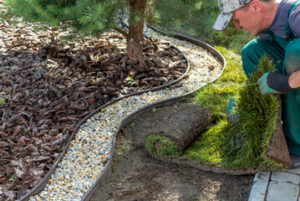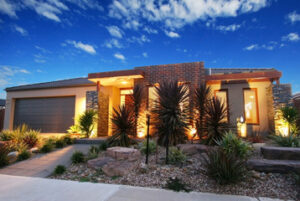A good landscape design features a variety of focal points, and this is especially important in a small space.
Landscapers Harrisburg PA will also use a variety of plant heights in their designs. This creates layers of visual interest and will make the space feel larger.

Many plant breeders have developed compact and narrow-growing trees and shrubs that are perfect for landscaping small spaces. Examples include ‘Skyrocket’ juniper (Juniperus scopulorum) and ‘Slender Silhouette’ sweet gum (Liquidambar styraciflua).
Plant Vertically
Many small garden ideas revolve around planting horizontally, but going vertical with your landscape is a great way to add more greenery and plant life to your space. There are several prefabricated vertical gardening structures you can purchase to hang in your backyard, but it’s also easy to create your living wall or garden with a few DIY projects.
A trellis or a vine-covered pergola is a beautiful addition to any yard, but you can also make your DIY vertical garden out of just about anything – from recycled planters to repurposed wood pallets to even old buckets. These structures can be filled with anything from flowers to herbs to vegetables to houseplants, and they’re the perfect backdrop for climbing plants like ivy, roses, or morning glory seeds.
Some vegetables require a deep root system that’s difficult to grow vertically, so be sure to check with a landscaping professional before planting your edible garden on a wall. Leafy greens and herbs, however, have shallow root systems and are ideal for this kind of planting.
If you don’t have a lot of money to spend on a new structure for your vertical garden, try repurposing a door or window frame instead. A little paint and a few sturdy ties will transform your old piece of furniture into a lovely hanging planter for succulents, herbs, or more. For something a bit more personalized, monogram your patio with a succulent-filled wall planter shaped to resemble your initials.
Planting a flower bed or vegetable garden in your backyard is a wonderful way to bring some natural beauty and fresh produce into your space, but it’s not always an option for smaller yards. For these landscapes, consider using container plants like window boxes, large pots, or found objects (like wheelbarrows or old buckets) that can be moved indoors when the weather turns cool.
Create Layers of Plants
Landscape layering is a key technique to bring balance, structure, and enchantment to your garden. It involves planting a foreground, middle, and background with plants of varying heights that add interest and color to the yard. When you’re landscaping small spaces, this can be even more important because there is less space to fill with larger plants.
Plants like Sambucus ’Sutherland’s Gold’ and Sambucus ’Black Lace’, Forsythia, rhubarb, hebes, and many Pittosporum species can provide height in the foreground of garden beds, while low to medium shrubs can be planted behind them that grow quickly, fill out nicely and provide a dense backdrop. Many of these types of plants can also be pruned severely each year to help them keep their shape. And then at the very back of a garden bed, you can plant a slow-growing, flowering groundcover such as thyme or a variety of native flowers to provide a bright pop of color and lure pollinators into your landscape.
A great way to create layers of plants is by running trailing vines down the side of a trellis or along the base of a wall, as shown above. Not only does this maximize the amount of greenery in a small area, but it also softens hard surfaces and helps them blend into the overall design of the yard.
As with all aspects of landscaping, careful consideration and regular maintenance are key when you’re working with a small space. But, if you’re willing to take the time and effort to assess your space, make use of vertical surfaces, borrow scenes from the landscape beyond your property, scale down your materials, double up uses, and incorporate seasonal maintenance, then there is no reason why your small yard can’t be a lush oasis.
Add A Water Feature
A water feature can make a small yard look and feel bigger. A fountain, waterfall, or rock pond is a great choice. Flowing water is not only soothing to the ear, but it can also mask noise from traffic or neighbors and attract butterflies and other wildlife.
If you do decide to have a fountain, it’s important to place it correctly. Be sure to situate it away from areas where weeds might grow, and keep the water moving to prevent stagnation. Then, plant around it to create a natural, flowing landscape design.
Another way to increase visual interest in a small yard is to mix different textures. For instance, instead of using all pavers for walkways or patios, use a mixture of stone, gravel, and wood mulch. This makes the yard more visually interesting and allows you to add more plants and color throughout your landscaping.
It’s also a good idea to plant a mixture of perennials and annuals. Not only does this offer more color throughout the year, but it will allow you to replant some of your favorites once they finish blooming. This will save you time and money and give you more variety to enjoy in your backyard.
Many people have a love-hate relationship with their lawns. They are functional for play, but they can be high maintenance and a major water guzzler. If you have a small space, consider removing the grass and replacing it with more colorful pollinator plants or edible gardens. If you still want to keep the grass, try framing it with garden edging or barriers, like this birch tree, to separate it from other areas of the landscape.
Create Cozier Spaces
When decorating small spaces, the right accent pieces can make a huge difference. For example, adding lavender plants will create a soothing scent and help the space feel more welcoming. Candles and pictures also add a cozy feel to the space and can be an easy way to decorate without consuming too much space.
Once you’ve established the function of your small space, you can plan accordingly. This may mean shunning traditional lawns and opting for a paved patio that can serve as an outdoor living room, or adding a fire pit for backyard Friday night s’more parties. You’ll also want to include focal points to help guide the eye throughout your landscape.
Double Up On Uses
When creating your small landscape, it’s important to think about how you want to use your space – this helps in determining what plants and features are the best fit. For example, if you’re designing a yard for entertaining, adding a fire pit could be a good way to bring people together. Or, if you have kids, installing a tree swing can be a fun activity for them to play on now and double as a flower garden for when they outgrow it.
Landscaping for small spaces requires careful planning and attention to detail, but it can also be fun and exciting. By scaling down your landscape materials, borrowing scenes from the surrounding environment, using textures and layers to create visual depth, and double-up on uses wherever possible, you can transform your backyard into a green oasis that you’ll love spending time in.
No matter what the size of your yard, it contains different microclimates that require different types of care. These microclimates include shady spots, sunny areas, dry areas, and wet areas. Consider these factors when choosing your plants, and don’t be afraid to mix up your landscaping styles. Someone recommends tropical gardening ideas like exotic evergreens and tree ferns, which add drama and color to the landscape while providing low-maintenance foliage.
If you’re unsure how to incorporate these elements into your small garden design, seek the help of a professional landscaper. They can guide you in designing a functional and attractive landscape for your home that will be the envy of the neighborhood!
